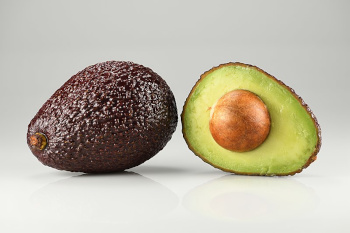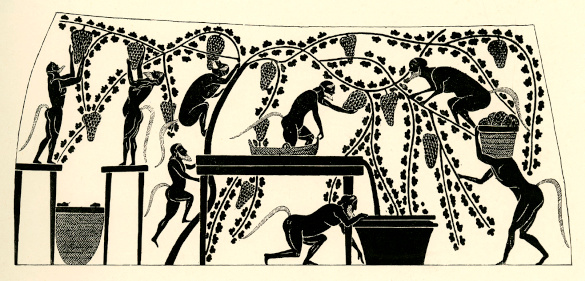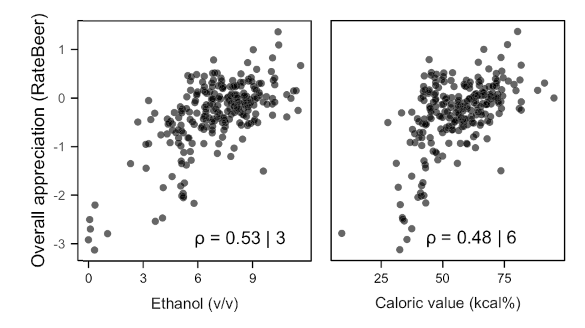| Tikalon Blog is now in archive mode.
An easily printed and saved version of this article, and a link
to a directory of all articles, can be found below: |
|
This article |
| Directory of all articles |
A.I., Wine, and Beer
June 10, 2024
Science and
technology have enhanced the
safety of our
food supply in many ways, such as
preservation by freezing and
vacuum packing. Food
variety has been enhanced, albeit with a significant
carbon footprint, by
air transport that brings us fresh
seasonal fruits out of
season.
Food chemistry has also given us
preservatives and other
additives, including
flavorings

I've never been a member of the avocado toast crowd, but the avocado is a good example of modern food distribution.
Once harvested, avocados ripen in one to two weeks at room temperature; so, reasonably rapid transport from Latin America to North American destinations is required to ensure freshness. Ethylene gas will hasten ripening, a technique that's common for other fruits.
(Haas avocado, grown in Colombia, Wikimedia Commons image by Iafar)
There's also a
dark side to
food science that includes the
addition of too much
sugar,
salt and
fat to make
bland processed foods more
palatable; and, often,
addictive. More
insidious is the use of
genetic engineering in
terminator technology that makes
plant seeds sterile. Fortunately, such things have had
considerable opposition.
The Bob New hart Show had a
humorous scene involving technological excess in reducing the
expense of food processing. In an episode of that
television sitcom, Elliot Carlin, a
serial entrepreneur and
perennial patient of Newhart's
psychologist character played by
Jack Riley (1935-2016), brings Bob a
bottle of
whiskey. The whiskey was "Von Krueger's, the only whiskey
aged in
styrofoam kegs."
In my fifty years of
monitoring the
scientific literature, I've seen many studies that used
scientific instrumentation, mostly
gas chromatography, in attempts to find what distinguishes a
superb wine from an inexpensive
house wine.[1] A typical wine can contain more than 800 different
aroma compounds; and, of these, just 10%-20% are known compounds.[1] A study by the
Australian Wine Research Institute examined two
Australian red wines made from the
Syrah grape, a
dark-skinned variety grown throughout the world.[1]
The object of this research was an attempt to
synthetically recreate the aroma of these wines.[1] It was found that only about 50 aroma compounds could be detectable by
smell, and only about 28 were present in large enough quantities to
theoretically make a difference to the aroma.[1] However, it was found that a minimum of 44 compounds were necessary to approximate the smell, and that certain compounds had a major affect on the final aroma.[1]

Satyrs harvesting grapes in a scene from an Attic amphora. wine has been with us for at least three millennia. Homer's Iliad describes its use during the Trojan War, thought to have occurred circa 1194-1184 BC and confirmed by archaeological evidence. (Wikimedia Commons image by British draughtsman, Dugald Sutherland MacColl (1859-1948), and contained in Greek Vase Paintings by Jane Ellen Harrison and D.S. MacColl, T.F. Unwin Publisher (London: 1894).Marcus Cyron from a sketch by )
Some
chefs think that "Everything is better with
butter," a
sentiment with which J
Julia Child (1912-2004) concurred. Today's
software mantra is, "Everything is better with
AI (artificial intelligence)." It's therefore not surprising that artificial intelligence has been applied to identification of wine quality through determination of where the grapes were grown.[2-3] This research was done by
scientists from the
University of Geneva and the
Institute of Vine and Wine Science at the
University of Bordeaux (Nouvelle-Aquitaine, France).[2-3] This was no easy task, since minor differences in
chemical composition will affect a wine's
flavor.[3] Multiple factors, such as the
soil characteristics,
climate, the variety of grape,
microbiology of
fermentation, and the
wine-maker's practices, will all affect the wine's flavor.[2]
This research was the first time that the exact origin of a wine was determined solely based on its chemical makeup.[3] To do this, the team applied gas chromatography and
electron ionization mass spectrometry to the problem of finding
Bordeaux wine chemical identities and
vintages (harvest year).[2] They analyzed chromatograms from 80
red wines from 12 vintages in the years 1990-2007 across seven Bordeaux
estates.[2-3] For
data analysis, the researchers used the artificial intelligence technique of
machine learning in which
algorithms learn to recognize
patterns in
data to process the chromatography data for each wine, which could include up to 30,000
data points.[3]
It was found that the estate could be identified perfectly, and the vintage with up to 50%
accuracy.[2] It appears that the
chemical identity of a wine is not defined by just a few
chemical compounds, but is a
function of its full chemical complement.[2] What's significant is that the method analyzed the entire chromatogram,
background noise included, and let the machine learning algorithm find the most
informative parts of a chromatogram.[2-3] Each estate possessed an unique chemical signature, and the method would be an effective way to combat wine
counterfeiting.[3]
A study similar to that for wine was done for
beer.[4-5] A research group of
Belgian scientists comprised of members from
Vlaams Instituut voor Biotechnologie (Leuven, Belgium),
Katholieke Universiteit Leuven (Leuven, Belgium),
Leuven Institute for Beer Research (Leuven, Belgium), and
AB InBev SA/NV (Leuven, Belgium) have developed models using artificial intelligence to predict how a particular beer will be rated by
consumers, and what aroma compounds can be added to improve it.[5]
In the study, they combined chemical analyses and taste-testing data of a set of different
commercial beers to predict taste, smell, and
mouthfeel from compound concentrations.[4] Beer is one
product that can be improved by modification, since it has thousands of flavor compounds derived by a mix of
raw materials consisting of
malt,
yeast,
hops,
water and
spices, and their evolution through
biochemical conversions during
brewing consisting of
kilning,
mashing,
boiling,
fermentation,
maturation and
aging.[4] The research study began with fewer than a hundred beers, but it was expanded to 250 commercial beers over 22 beer styles, for which more than 200 chemical properties were characterized and
ranked by a sixteen person testing panel combined with more than 80,000 public consumer reviews.[4-5] The study took five years to complete.[5]

Light beer be damned! These correlations show a definite preference for ethanol and caloric value in beer. The Spearman Rho correlation coefficient is graphed. (Portions of fig. 4c of ref. 4, distributed under a Creative Commons Attribution 4.0 International License.[4] Click for larger image.)
It was found that an algorithm called
gradient boosting led to accurate prediction of taste preference from chemical profiles.[4]
Reverse engineering of the
models identified specific and unexpected compounds as important to beer flavor and appreciation; and, adding these compounds to both
alcoholic and
non-alcoholic beers led to a greater consumer appreciation.[4] This modeling is a basis for
quality control, including detection of
food spoilage,
product fingerprinting, and counterfeit detection.[4] The research team's future goal is making better alcohol-free beer.[5]
References:
- How is Wine Aroma Re-Created Using Gas Chromatography?, Chromatography Today, May 23, 2014.
- Michael Schartner, Jeff M. Beck, Justine Laboyrie, Laurent Riquier, Stephanie Marchand, and Alexandre Pouget, "Predicting Bordeaux red wine origins and vintages from raw gas chromatograms," Communications Chemistry, vol. 6, article no. 247 (December 5, 2023), DOI: https://doi.org/10.1038/s42004-023-01051-9. This is an open access paper with a PDF file at the same URL.
- The Chemical Footprint of Wine: A Breakthrough in Identifying Vintage Origins, vinetur.com, January 19, 2024.
- Michiel Schreurs, Supinya Piampongsant, Miguel Roncoroni, Lloyd Cool, Beatriz Herrera-Malaver, Christophe Vanderaa, Florian A. Theßeling, Łukasz Kreft, Alexander Botzki, Philippe Malcorps, Luk Daenen, Tom Wenseleers, and Kevin J. Verstrepen, "Predicting and improving complex beer flavor through machine learning," Nature Communications, vol. 15, article no. 2368 (March 26, 2024), DOI: 10.1038/s41467-024-46346-0. This is an open access paper with a PDF file at the same URL.
- AI predicts the taste and quality of beer, Vlaams Instituut voor Biotechnologie Press Release, March 26, 2024
Linked Keywords: Science; technology; safety; food supply; frozen food; preservation by freezing; vacuum packing; variety; carbon footprint; aviation; air transport; seasonal food; fruit; season; food chemistry; preservative; food additive; flavorings; avocado toast; cultural identity; crowd; avocado; modern history; food distribution; harvest; harvested; ripening; ripen; week; room temperature; Latin America; North America; ethylene gas; ethylene (plant hormone); hasten ripening; fruit; Haas avocado; Colombia; Iifar; evil; dark side; food science; sucrose; sugar; salt; fat; taste; bland; processed food; palatability; palatable; addiction; addictive; insidious; genetic engineering; genetic use restriction technology; terminator technology; plant seed; sterilization (microbiology); sterile; Monsanto terminator seeds; considerable opposition; The Bob New hart Show; humor; humorous; scene (filmmaking); expense; television sitcom; entrepreneurship; serial entrepreneur; perennial; patient; psychologist; character (arts); Jack Riley (1935-2016); bottle; whiskey; aging (food); styrofoam; keg; monitor; scientific literature; scientific instrument; gas chromatography; classification of wine; superb; wine; house wine; aroma compound; Australian Wine Research Institute; Australia; Australian; red wine; Syrah grape; skin; chemical synthesis; synthetically; olfaction; smell; theory; theoretically; Satyr; harvest; harvesting; grape; scene; classical Athens; Attic; amphora; wine; millennia; Homer; Iliad; Trojan War; Anno Domini; BC; archaeology; archaeological; Wikimedia Commons; Great Britain; British; draughtsman; Dugald Sutherland MacColl (1859-1948); Marcus Cyron; chef; opinion; think; butter; feeling; sentiment; Julia Child (1912-2004); computer software; mantra; AI (artificial intelligence); scientist; University of Geneva; Institute of Vine and Wine Science; University of Bordeaux (Nouvelle-Aquitaine, France); chemical composition; flavor; soil quality; soil characteristics; climate; microbiology; fermentation; winemaker; vintner; inductively coupled plasma mass spectrometry; electron ionization mass spectrometry; Bordeaux wine; vintage; red wine; vineyard; estate; data analysis; machine learning; algorithm; pattern; data; data point; accuracy; chemistry; chemical; identity (philosophy); chemical compound; function (mathematics); background noise; nformation; informative; counterfeit; counterfeiting; beer; Belgium; Belgian; Vlaams Instituut voor Biotechnologie (Leuven, Belgium); Katholieke Universiteit Leuven (Leuven, Belgium); Leuven Institute for Beer Research (Leuven, Belgium); AB InBev SA/NV (Leuven, Belgium); consumer; commerce; commercial; mouthfeel; product (business); raw material; malt; yeast; hops; water; spice; biochemistry; biochemical; brewing; kilning; mashing; boiling; fermentation (food); maturation; barrel-aged beer; aging; ranking; ranked; preference for ethanol and caloric value in beer; light beer; damnation; damned; correlation; preference; ethanol; caloric value; Spearman Rho correlation coefficient; Creative Commons Attribution 4.0 International License; gradient boosting; reverse engineering; mathematical model; alcoholic beverage; low-alcohol beer; non-alcoholic beers; quality control; food spoilage; authentication; product fingerprinting.